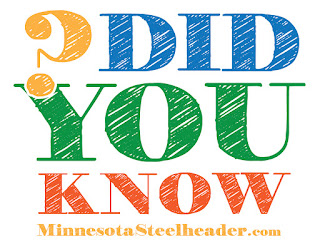Did you know? - Upstream boundaries
 The North Shore (including Duluth area) has 73 tributaries listed with upstream boundaries. These boundaries are typically located at areas with a natural barrier, such as a high waterfall, preventing fishing migration upstream. Designated trout streams typically have different angling regulations for above and below barrier. See the 2018 fishing regulations HERE.
The North Shore (including Duluth area) has 73 tributaries listed with upstream boundaries. These boundaries are typically located at areas with a natural barrier, such as a high waterfall, preventing fishing migration upstream. Designated trout streams typically have different angling regulations for above and below barrier. See the 2018 fishing regulations HERE.Below barrier is where Steelhead anglers focus their efforts, yet many anglers are unclear where these barriers are. Lets add some clarity.
Though listed, many of the North Shore tributary may not get much, if any steelhead migration in a given year. This is due mainly to stream size, flow, and distance. Many listed tribs. are a mere trickle of water, but a spring thaw with above normal flow can trigger a surprise for those adventurous anglers.
The link below is a listing of upstream Posted Boundaries and Fish Sanctuaries on North Shore tributaries to Lake Superior. It was revised in December 2016 so it is pretty accurate. Streams not listed have no upstream boundary and are subject to below-boundary regulations throughout their length.
Upstream boundaries list - Click Here
Example: Gooseberry River: US Hwy. 61; T. 54, R. 9, S. 22: (UTM Easting) 616142 (UTM Westing) 5222238
 The specifications are outlined more clear than this, but this gives an idea of the location language. To most this may be like a foreign language. We will not go in-depth here on the technical, rather just some basics. We recommend some googling if you need assistance with map reading and way-finding.
The specifications are outlined more clear than this, but this gives an idea of the location language. To most this may be like a foreign language. We will not go in-depth here on the technical, rather just some basics. We recommend some googling if you need assistance with map reading and way-finding.Each upstream boundary and fish sanctuary location has a nearby road listed - this is most important to us anglers. It will also have 3 letters with 3 numbers. The letters (T)Township, (R)Range, (S)section are boundary classifications. Beginning in the late 1840s, our federal government began surveying Minnesota as part of the Public Land Survey System (PLSS). The resulting web of land survey lines divided the state into townships, ranges, sections. It actually went a bit further into quarter sections, quarter-quarter sections and government lots, laying a foundation for today's land ownership mapping.
The UTM Easting and Northing numbers are added to further pinpoint each upstream boundary location. The terms easting and northing are geographic coordinates for a point. Easting refers to the eastward-measured distance (or the x-coordinate), while northing refers to the northward-measured distance (or the y-coordinate). These coordinates are most commonly associated with the Universal Transverse Mercator coordinate system (UTM), which has unique zones that cover the Earth for precise referencing. Once again you can search the web for a better understanding of the UTM system.
 Don't let the geographic coordinates get you too confused, they are there for pinpointing. As anglers we already are on the water, we just need to find the upstream boundary. Keep in mind to what was previously mentioned - there is a geological barrier that claims the upstream boundary.
Don't let the geographic coordinates get you too confused, they are there for pinpointing. As anglers we already are on the water, we just need to find the upstream boundary. Keep in mind to what was previously mentioned - there is a geological barrier that claims the upstream boundary. Check out the link, look at the info, find the reference road on a map and you should be able to figure out the upstream location for your favorite river. We hope this helps you gain more of an edge.
Upstream barriers on the MN tributaries of Lake Superior.



Comments
Keep up the good work!